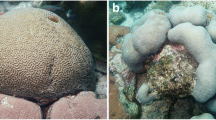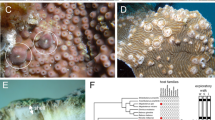Abstract
Trapezia ferruginea appears to depend entirely on its coral host (Pocillopora spp.) for shelter and food. Field and laboratory experiments have shown that the brightly colored crabs move between colonies at night. Analysis of movements in crabs randomly distributed among randomized Pocillopora damicornis colonies under laboratory conditions showed that after 6 days there was a significant increase in the number of heterosexual pairs (P<0.001) and a significant correlation between the number of crabs and the size of colonies (P=0.003), as well as between the size of crabs and the size of colonies (P=0.020) — conditions which are also observed in the field. No such correlations were obtained (P>0.05) in a similar experiment where very intense predation by carnivorous fishes was present. This host selection by adults appears to be elicited by the lack of a suitable partner and the inadequate size of their established territory in the colony.
Similar content being viewed by others
Literature Cited
Abele, L.G.: Comparative species richness in fluctuating and constant environments: coral associated decapod crustaceans. Science, N.Y. 192, 461–463 (1976)
— and W.K. Patton: The size of coral heads and the community biology of associated decapod crustaceans. J. Biogeogr. 3, 35–47 (1976)
Barry, C.K.: Ecological study of the decapod crustaceans commensal with branching coral Pocillopora meandrina var. nobilis Verrill, 64 pp. Master of Science thesis, University of Hawaii, Honolulu 1965
Castro, P.: Nutritional aspects of the symbiosis between Echinoecus pentagonus and its host in Hawaii, Echinothrix calamaris. In: Aspects of the biology of symbiosis, pp 229–247. Ed. by T.C. Cheng. Baltimore: University Park Press 1971
— A new host and notes on the behavior of Tuleariocaris neglecta Chase, 1969 (Decapoda, Palaemonidae, Pontoniinae), a symbiont of diadematid sea urchins. Crustaceana 26, 318–320 (1974)
— Brachyuran crabs symbiotic with scleractinian corals: a review of their biology. Micronesica 12, 99–110 (1976)
Emlen, S.T. and L.W. Oring: Ecology, sexual selection, and the evolution of mating systems. Science, N. Y. 197, 215–223 (1977)
Garth, J.S.: The brachyuran crabs of Easter Island. Proc. Calif. Acad. Sci. 39, 311–336 (1973)
Gerlach, S.: Über das tropische Korallenriff als Lebensraum. Zool. Anz. (Suppl.) 23, 356–363 (1960)
Glynn, P.W.: Acanthaster: effect on coral reef growth in Panamá. Science, N.Y. 180, 504–506 (1973)
— Some physical and biological determinants of coral community structure in the Eastern Pacific. Ecol. Monogr. 46, 431–456 (1976)
—, R.H. Stewart and J.E. McCosker: Pacific coral reefs of Panamá: structure, distribution and predators. Geol. Rdsch. 61, 483–519 (1972)
Hiatt, R.W. and D.W. Strasburg: Ecological relationships of the fish fauna on coral reefs of the Marshall Islands. Ecol. Monogr. 30, 65–127 (1960)
Johnson, V.R.: Behavior associated with pair formation in the banded shrimp Stenopus hispidus (Oliver). Pacif. Sci. 23, 40–50 (1969)
Knowlton, N.: Pair bonds in a snapping shrimp commensal with a sea anemone. Am. Zool. 16, p. 197 (1976)
Knowlton, N. The nature and adaptive significance of pair bonds in the snapping shrimp Alpheus armatus, a commensal of the sea anemone Bartholomea annulata, Ph.D. thesis, University of California, Berkeley 1977
Knudsen, J.W.: Trapezia and Tetralia (Decapoda, Brachyura, Xanthidae) as obligate ectoparasites of pocilloporid and acroporid corals. Pacif. Sci. 21, 51–57 (1967)
Lassig, B.R.: Communication and coexistence in a coral community. Mar. Biol. 42, 85–92 (1977)
Patton, W.K.: Community structure among the animals inhabiting the coral Pocillopora damicornis at Heron Island, Australia. In: Symbiosis in the sea, pp 219–243. Ed. by W.B. Vernberg, Columbia, S.C.: University of South Carolina Press 1974
Pearson, R.G. and R. Endean: A preliminary study of the coral predator Acanthaster planci (L.) (Asteroidea) on the Great Barrier Reef. Fishery Notes Dep. Harbours Mar., Qd 3, 27–51 (1969)
Preston, E.M.: Niche overlap and competition among five sympatric congeneric species of xanthid crabs, 125 pp. Ph.D. thesis, University of Hawaii, Honolulu 1971
— A computer simulation of competition among five sympatric congeneric species of xanthid crabs. Ecology 54, 469–483 (1973)
Schein, H.: Aspects of the aggressive and sexual behaviour of Alpheus heterochaelis Say. Mar. Behav. Physiol. 3, 83–96 (1975)
Siegel, S.: Nonparametric statistics for the behavioral sciences, 312 pp. New York: McGraw-Hill 1965
Weber, J.N. and P.M.J. Woodhead: Ecological studies of the coral predator Acanthaster planci in the South Pacific. Mar. Biol. 6, 12–17 (1970)
Author information
Authors and Affiliations
Additional information
Communicated by J.M. Lawrence, Tampa
Rights and permissions
About this article
Cite this article
Castro, P. Movements between coral colonies in Trapezia ferruginea (Crustacea: Brachyura), an obligate symbiont of scleractinian corals. Mar. Biol. 46, 237–245 (1978). https://doi.org/10.1007/BF00390685
Accepted:
Issue Date:
DOI: https://doi.org/10.1007/BF00390685




